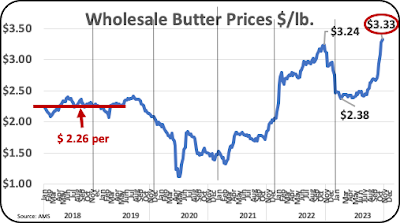The new buzzword for the dairy industry is sustainability. The USDA defines sustainability as "Sustainable agriculture is farming in such a ways to protect the environment, aid and export natural resources and to make the best use of nonrenewable resources." Dairy needs to provide food that is desirable, healthy, and affordable. U.S. dairies are doing just that. Today's dairy products primarily need healthy components, like butterfat and protein. When the amount of these components in milk increases, the needed components can be supplied with fewer cows and at lower cost. This post will cover the trends that accomplish these requirements.
The data used in this post is Federal Order averages. Individual producers do achieve significantly higher levels of components.
BUTTERFAT
Chart I shows the trends in butterfat production as a percent of milk. The increases are steady and ongoing. How long can these trends continue to grow? The gains are clearly not slowing down. From the beginning on 2018 to the most current month of August 2023, butterfat in milk has increased from 3.83% to 4.09% (Chart I).
 |
| Chart I - Average percent of Butterfat in Milk |
The increases in butterfat volume are growing by over 1% annually (Chart II). A producer with 3000 cows with each producing 30,000 pounds of milk annually would get 36,000 more pounds of butterfat than the prior year.
90,000,000 pounds of milk with 4% butterfat and increasing butterfat by 1% annually = 36,000 more pounds of butterfat annually
The increase builds annually. If at 4% butterfat, a one percent increase would make the butterfat percent go to 4.04% and the next year to 4.08% etc. Using protein's current price of $3.13 per pound, the producer would get $113,000 more revenue than the prior year with no additional cows.
 |
| Chart II - Annual Percent Growth in Butterfat |
The Federal Orders with the highest and lowest percent butterfat are listed below (Table I). The four with the lowest butterfat content are the four Federal Orders paid on the Advanced prices. These four do get paid for their butterfat just like those paid on the Class and Component prices.
 |
Table I - Butterfat Percent
by Federal Order |
MILK PROTEIN
Milk Protein has also seen similar increases in production. Over the last three years, protein volume in milk has grown by 1% annually, increasing protein levels from 3.15% at the start of 2018 to the present at 3.24% (Chart III).
 |
| Chart III - Annal Percent of Protein in Milk |
What is that worth? Following the math used for butterfat above, with 3000 cows producing 30,000 pounds of milk annually the producer would get a revenue increase of $67,000 annually.
(90,000,000 pounds of milk with 3.26% protein with a 1% increase over prior year = 29,000 more pounds of protein)
Priced at the current price of $2.30 per pound, the producer would get $67,000 more revenue than the prior year based on increased protein production. This would be cumulative every year.
 |
| Chart IV - Annual Percent Growth in Protein |
Protein is paid for in the seven Federal Orders paid on the Class and Component system. As shown in Table II, the .23% spread between the seven Orders is relatively small, compared to the .54% spread for butterfat shown in Table I.
 |
Table II - Protein Percent
by Federal Order |
SOMATIC CELL COUNT
Somatic Cell Count (SCC) is included in the published component data and will therefore be included in this post. Since the SCC broke the 195,000 cells per milliliter level, there has been no significant improvement in lower SCCs. The Upper Midwest and the Mideast have the lowest SCCs at 178,000 somatic cells,
 |
| Chart V - Average Somatic Cell Count |
SUMMARY
The gains in volume for butterfat and protein are a tremendous improvement for both sustainability and for improved producer revenue. There are various technics for improving butterfat. There is one main improvement for increasing milk protein and that is amino acid balancing cf feed. Amino acid balancing also improves butterfat volume creating a combined return on the investment for feeding the proper level of needed amino acids. The technology has been practiced for a long-time and is well proven.
























































